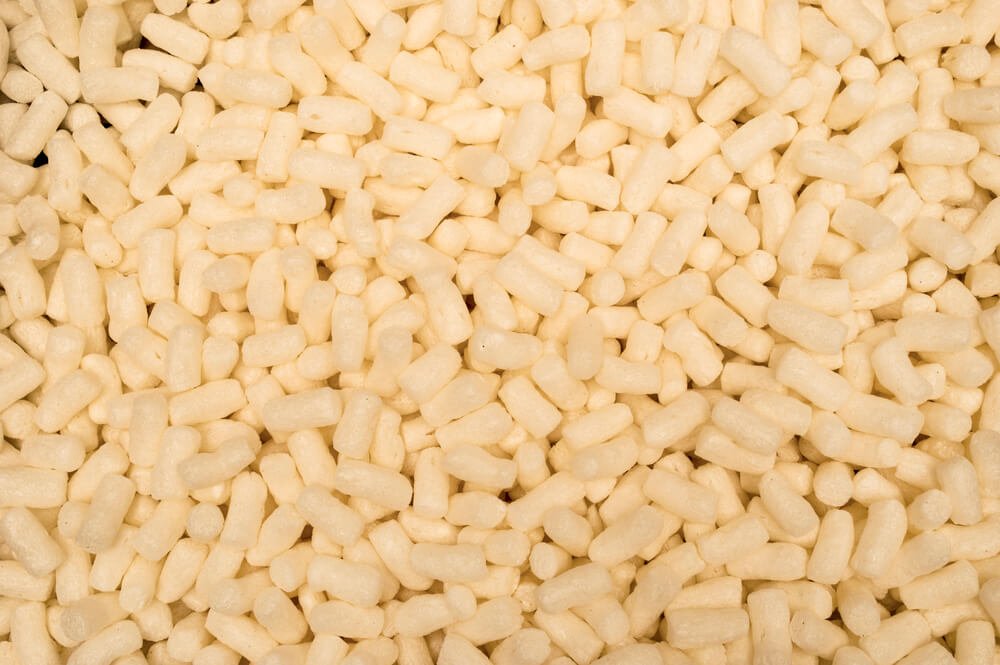We’ve all ordered packages that deliver giant boxes full of packing peanuts.
Sure, it might be a great way to prevent breakage on a fragile item, but we are then left wondering what to do with a box full of Styrofoam “peanuts” after delivery.
Will it fit in the trash, can it be recycled, and will all of this cause an unwanted environmental impact?
Packing peanuts have long been a conundrum and with delivery services only increasing since the COVID-19 pandemic, understanding how to dispose of these peanuts has become a more pressing need.
Biodegradable vs Standard Packing Peanuts
The first thing you need to know about disposal is what kind of packing peanuts you are working with.
What you can do with biodegradable vs “standard” or traditional packing peanuts varies greatly.
Traditional peanuts are made out of a foam called polystyrene.
Polystyrene is not biodegradable and cannot be recycled (technically it can only be recycled into more Styrofoam), but it is highly resistant to degrading too soon and makes a very effective packing tool. While this material has waned in popularity, it is still used by many to ship fragile items.
How to tell when you have biodegradable packing materials
Biodegradable packing peanuts (and other materials) will look different to the “naked eye” than polystyrene foam.
Biodegradable peanuts are typically plant-based, which provide a tan or light green color.
Traditional peanuts will be a bright white or even pink — think natural dye vs synthetic.
In addition to looking at the peanuts to decide what type of packing you have, you can run a piece of the material underwater.
In simple terms, biodegradable items should begin to dissolve, synthetic or non-recyclable items will be fine.
In addition, only synthetic foam peanuts will create a static charge and stick to your clothing.
Dispose of Packing Peanuts by Reusing
The first method of disposing of packing peanuts is to simply re-use these for a different package.
In fact, this method of reuse is an effective way to limit landfill material with both biodegradable and Styrofoam materials.
Reusing your material is handy if you have a storage area for the box it came in or if you will be shipping another item soon.
In addition, you might end up saving some money by avoiding the purchase of new items for shipping as well.
While not a permanent solution, reusing items that are in good condition is always an eco-friendly hack worth trying.
Disposing of Biodegradable Packing Peanuts by Dissolving
As mentioned above, plant-based packing peanuts tend to be dissolvable — but exactly how you should manage this may depend on the type of material used to create these packing peanuts and your area.
Common techniques include using cornstarch or wheat. If peanuts are green in tint this indicates the material is made with 70% recycled material as well.
All plant-based packing peanuts should dissolve with water and moisture.
The exact material composition will dictate how fast this happens, but the process is generally the same.
Disposing of Peanuts via Water
Another highly common method to dispose of biodegradable packing peanuts is to run them under water and let them dissolve.
In theory, you can do this anywhere and the substance should be fine, but as practical advice, it’s best not to send anything extra down your pipes.
Warm water is most effective to dissolve these peanuts, but older or partially clogged pipes may be susceptible to even the smallest amount of plant matter.
Why take any chances?
Instead, run under water outside with a hose or at least inside with garbage disposal as a backup.
Referring back to those different materials, not all biodegradable packing peanuts are compostable, but some are.
The difference means that biodegradable items will all eventually degrade, although some may take years unassisted.
Compostable means you can instantly toss these items on the compost pile and are regulated by US Standard ASTM D6400-99 and European Standard EN 13432, although it can be hard to tell the difference. If in doubt, don’t compost.
Disposing of Peanuts via Compost
Those who live in warmer climates, or wet and warm climates often favor sending packing peanuts to the compost pile.
All this requires is dumping the peanuts on the moist and warm area and letting them degrade with time.
Those who like a neat area should try to make sure the top peanuts don’t blow away in the wind, however.
Compost disposal should be avoided if your climate is very dry or prone to freezing.
While the peanuts won’t likely do any harm, they are also unlikely to dissolve as fast as desired.
So don’t stress if you get a box of packing peanuts — it may be easier to dispose of than you think.
Check your materials and perform a few simple tests to determine the best method to get rid of these light and effective packaging solutions.
Remember you can reuse, melt, or compost most solutions. Identify your material type and get ready to make some space at home.
There are many solutions to common household disposal problems, learn more now.


